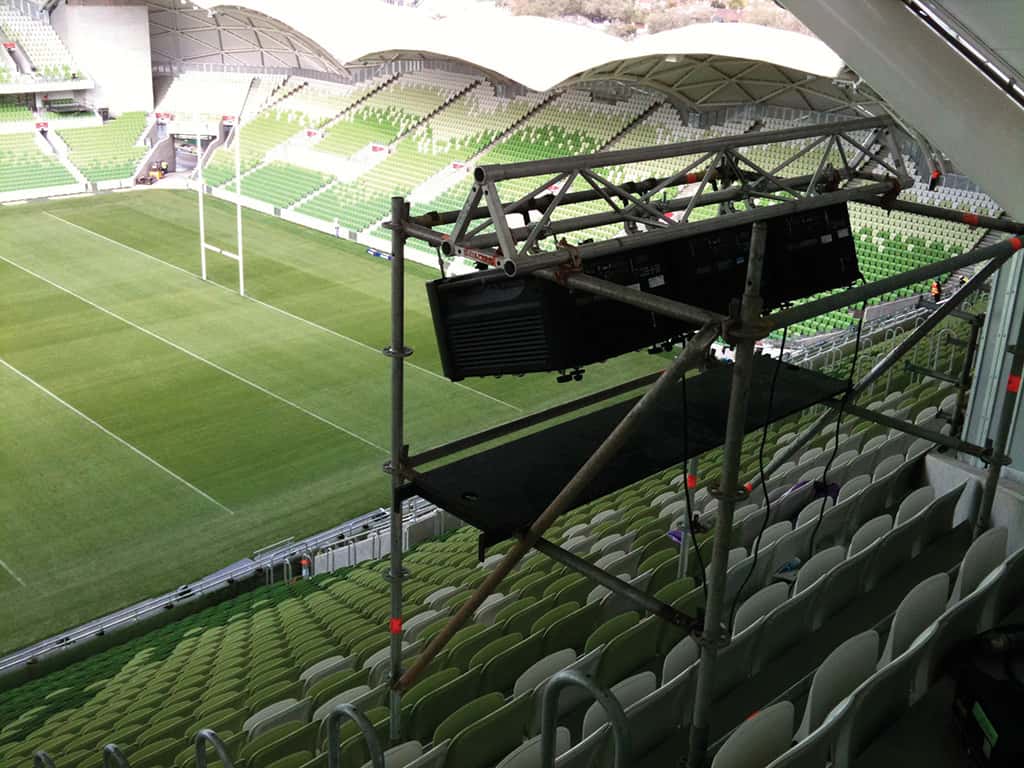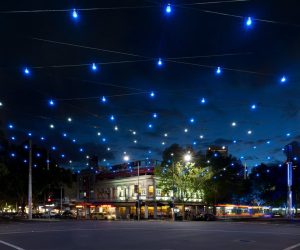
AAMI Park: Opening, Ready or Not
Production Manager, Nick Macfie, relates the tale of a gig booked into a venue that was still under construction.
Text & images:\ Nick Macfie
Around late January or early February this year, while stumbling through one of my regular online haunts (The Cool Hunter) I come across something that stood out: it was then referred to as the Rectangular Stadium. Lit in triangle form by an intricate installation of LED lighting throughout the roof, it flashed, it moved, it changed colour… it was different… it was cool.
I wondered what lucky city had adopted such a cool stadium design. Upon further investigation, and much to my surprise, I discovered that it was Melbourne! Looking a little deeper, I realised the images were computer renders, so I supposed that much like the majority of content on The Cool Hunter website, this was probably a concept piece.
A little later I uncovered how misinformed and out of touch with current affairs I am. This stadium was in the final stages of construction; a true realisation of the design and vision by Cox Architects and the City of Melbourne.
Imagine my surprise again, when not even a month later, there we were, standing in the stadium under construction, receiving the first production briefing for the launch of this amazing venue with an Australia vs New Zealand, National Rugby League (NRL) test match.
Timesquare Productions, the NRL’s retained event management agency, appointed Tim Freeland, Creative Director of Splendid Communications to design and produce the opening ceremony to launch AAMI Park. These proceedings were to take place before the match kick-off and be broadcast nationally via the Nine Network on May 7th, 2010. Our company, Production Technologies, was engaged by Tim Freeland to manage all technical elements of the show, including audio, video, lighting, staging, communications, power and crew management.
Tim Freeland developed the design for the show that needed to take account of the requirements of stakeholders, including the NRL, the Melbourne & Olympic Parks Trust (MOPT – the owners of the venue), the Nine Network and AAMI (the naming rights holder). The program also had to incorporate an indigenous Welcome to Country and history of great Victorian sporting moments in the half hour live broadcast segment prior to the match.
PAVED WITH GOOD INTENTIONS
There’s nothing peachy about how this started. When we first visited the venue five weeks out from the event date, the roof was still held up by scaffolding the whole way around; all the control rooms were full-time workshops; and no mains power supply existed. As you can imagine, our conversations en route back to Sydney that afternoon weren’t brimming with confidence. A week out from bump-in not much had changed, except we’d actually noticed more problems: like how the roof leaked… a lot.
We were given the green light on the creative and execution of the production only three weeks prior to bump-in. All suppliers were anxiously standing-by to get moving, or at the very least, visit the site. Sure enough, gear started moving across the country to meet the requirements, crew started designing the systems, and we all started throwing the usual curve balls at each other; all before anyone had even touched an Excel spreadsheet or mentioned the word ‘induction’. Our final on-site production meeting was 10 days prior to bump-in, with all suppliers, members of MOPT, and the NRL, together with the principal building contractor and site managers. Nobody had to warn us this was going to be ‘interesting’, we knew.
The ability to hang anything from the roof structure was immediately dismissed by the building contractors, who responded as if it was some kind of ludicrous delusion. We fought hard for it, but we lost – not the kind of curve ball anybody wants 10 days out from the installation date. It was comforting to see three or four of the strongest production minds in the country keep their cool in this situation. Rather than throwing their toys out of the pram, it became a process of problem solving – problem solving on the run, you might say. A solution had to be devised for the flown elements of audio, video and lighting with only five or six days to go before the trucks had to be packed. It’s not as easy as just laying down the law that the lighting must hang, that the PA can just go on the field-of-play, and that the projectors can stack over seating. With the lead-time available, clearing these solutions with all the stakeholders was nearly impossible.

AUDIO: GET IT ON
Since it was unclear as to whether the house audio installation would be functioning in time, it was decided that the show system would need to be self sufficient if required. To achieve this, Norwest Production deployed a ground-based system consisting of 36 x L-Acoustics Kudo elements on their custom-made carts, accompanied by four EAW KF750 cabinets on their sides for the corners of the stadium. With the three corner carts linked together and attached to an electric buggy, we had the ability to strike the field in less than 60 seconds with eight crew.
Justin Arthur of Norwest was responsible for system tuning and also took on FOH mix duties. Full credit goes to Justin for tuning and time-aligning the system in a very small time frame while battling the noise of circular saws, drills, jackhammers, cement trucks, and about a thousand angry workmen.
In the end we were fortunate enough to be able to supplement the ground-based system with the house system – EAW AX series loudspeakers powered by Powersoft K3 amplifiers. The house system was very simple to integrate and provided an even and seamless blend for the upper grandstand. A major consideration in the design of the show system was the ability to feed the top- and rear-firing house boxes individually, allowing us to separately feed the top boxes as desired in the time-alignment process.
The entire ground system had to be struck from the field following the anthems in the one solitary minute prior to kick-off, on what ended up being a very soggy pitch following the rain. Note to Australian and New Zealand Rugby teams: when a rain-sodden electric cart fails to make it off the field due to a malfunction and holds up the kick-off, don’t be outdone by 20 Showsupport loaders who can push it off the field (well done lads!).
LIGHTING: SPECTACULAR
Lighting contractor Bytecraft Entertainment (led by Fergal O’Sullivan) and rigging contractor Show Tech Australia (led by Tiny Good and David Segan), worked closely together to overcome our inability to fly equipment from the roof. Instead the 256m of box truss was attached with Gackflex slings and countless burlaps to the balcony front of the tiered seating sections on the east and west sides of the stadium. A rig of 80 x Martin Mac 2000XB washlights sat on top of the box truss, spread evenly down each side of the field. These were supplemented by 10 x High End Systems Showgun and 4 x Syncrolite SXB-5/2 xenon moving lights, with Strong Gladiator 3kW xenon followspots at each corner of the stadium.
Show Tech also provided the much needed cable management truss, scaffolding and pits throughout the stadium. Being a brand new (and unfinished) venue there were no tie lines, no conduit, no cable trays, not even a hole in a wall to run a cable through.
Richard Neville of Mandylights provided the lighting design and operated the grandMA console, having already visualised the event in Sydney weeks earlier, sitting alongside Tim Freeland in the Mandylights studio. The result was a spectacular lighting show for both the live and broadcast audiences.
“”
The ability to hang anything from the roof structure was immediately dismissed by the building contractors, who responded as if it was some kind of ludicrous delusion


VISION: STRIKING
The most striking feature on the field-of-play for the ceremony was a 40m x 56m projection screen which was constructed from 350gsm PVC mesh in four panels and joined with Velcro. This enabled it to be struck from the field in less than two minutes by the 22-person crew.
Projection veteran Peter Milne and his company Electric Canvas was engaged to provide the projection solution for the event. They installed 18 x Christie Roadster S+20K projectors, nine either side of the stadium, on six scaffold towers built by Show Tech Rigging. The content from video creative house Engine was played back, and integrated with a live feed from the Channel Nine helicopter hovering above, through an E/T/C Onlyview system.
COMMS: A WORK OF ARTIST
Often given the least attention and the greatest number of insults, the communications were contracted to Josh Moffat at All Things Technical, who installed and managed the Riedel Artist system and two-way radios from bump-in until show-time, with flawless results. Josh comes with a lot of experience of sports communications, having frequently provided comms for NRL events. Based around an Artist digital matrix system, nodes were distributed across three fibre-linked locations.
The stadium control room housed a Riedel Artist 32 system frame which fed the 12 x 1000 Series panels for all show call and operational crew throughout the event, including additional panels for ground announce and game time control. Deployed to the rear of the north seating bowl were the RiFace interface units connecting all duplex and simplex radio channels into the matrix, together with an Artist 64 frame linked via a redundant fibre ring back to the control room.
ALL RIGHT ON THE NIGHT
Not often does a show come along where more pre-production is done on site than off, but watching all of these elements come together so smoothly was a truly gratifying end to a most adventurous week. Amazingly, it was all smiles at the end, from the crew, the clients and the sponsors; even in the pouring rain.
Apparently Australia won the game. I missed that minor detail on the night. Bonus.
PRODUCTION CREDITS
Show Producer: Tim Freeland (Splendid Communications)
Show Caller: Craig Claridge (Timesquare Productions)
Technical Director: Nick Macfie (Production Technologies)
Lighting Design / Operation: Richard Neville (Mandylights)
Stage Management: Robert Fischer (Timesquare Productions)
Audio Contractor: Norwest Productions
Project Manager: Nick Hutchinson
FOH Engineer / System Design: Justin Arthur
System Engineer: Andy Marsh
System Engineer: Aaron Mason
RF System Tech: Steve Caldwell
Lighting Contractor: Bytecraft Entertainment
Project Manager: Paul Rigby
System Engineer / Crew Chief: Fergal O’Sullivan
Video Contractor: The Electric Canvas
Project Manager: Peter Milne
Rigging Contractor: Show Tech Australia
Project Manager: Tiny Good
Communications Contractor: All Things Technical
Project Manager: Josh Moffat
Power Contractor: Event Power Solutions
Project Manager: Mark Jamison
Screen Contractor: Pattons Awnings
Project Manager: Daniel Halse
Staging Contractor: Staging Rentals Melbourne
Labour Contractor: Show Support
Project Manager / Crew Chief: Jamie Sparks
IT Network Contractor: Wired Sky Events
Project Manager: Matt Hall















RESPONSES